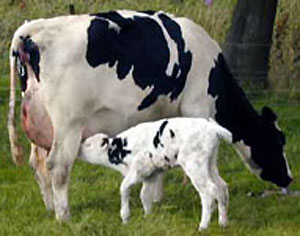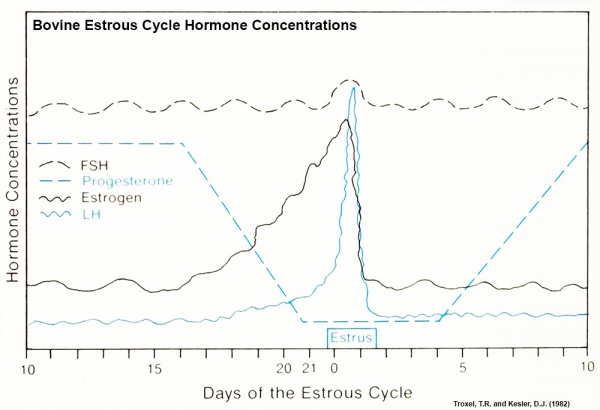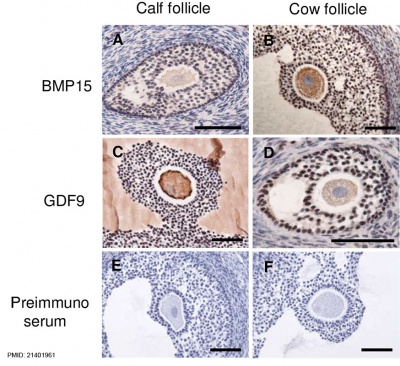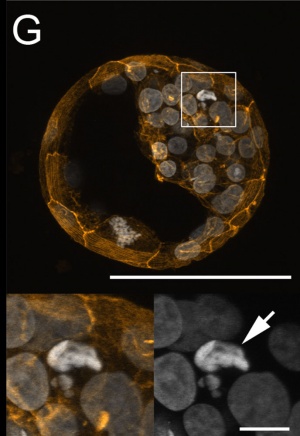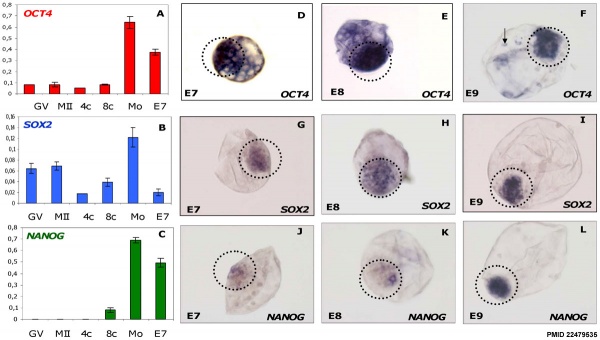Bovine Development
| Embryology - 18 Apr 2024 |
|---|
| Google Translate - select your language from the list shown below (this will open a new external page) |
|
العربية | català | 中文 | 中國傳統的 | français | Deutsche | עִברִית | हिंदी | bahasa Indonesia | italiano | 日本語 | 한국어 | မြန်မာ | Pilipino | Polskie | português | ਪੰਜਾਬੀ ਦੇ | Română | русский | Español | Swahili | Svensk | ไทย | Türkçe | اردو | ייִדיש | Tiếng Việt These external translations are automated and may not be accurate. (More? About Translations) |
Introduction
Bovine (taxon- Bos taurus) development is studied extensively due to the commercial applications of cattle both for milk and meat production.
| Cattle Gestation Periods | (Bovine Development) |
|---|---|
| Breed | Average Days (±7–10 days) |
| Angus | 281 |
| Ayrshire | 279 |
| Brahman | 292 |
| Brown Swiss | 290 |
| Charolais | 289 |
| Guernsey | 283 |
| Hereford | 285 |
| Holstein | 279 |
| Jersey | 279 |
| Limousin | 289 |
| Shorthorn | 282 |
| Simmental | 289 |
| Bovine Links: Bovine Development | Category:Bovine | ||
|
| Animal Development: axolotl | bat | cat | chicken | cow | dog | dolphin | echidna | fly | frog | goat | grasshopper | guinea pig | hamster | horse | kangaroo | koala | lizard | medaka | mouse | opossum | pig | platypus | rabbit | rat | salamander | sea squirt | sea urchin | sheep | worm | zebrafish | life cycles | development timetable | development models | K12 |
Some Recent Findings

|
| More recent papers |
|---|
|
This table allows an automated computer search of the external PubMed database using the listed "Search term" text link.
More? References | Discussion Page | Journal Searches | 2019 References | 2020 References Search term: Bovine Embryology <pubmed limit=5>Bovine Embryology</pubmed> |
Taxon
Bos taurus
Genbank common name: cow, bovine, domestic cattle
Taxonomy Id: 9913 Rank: species
Genetic code: Translation table 1 (Standard)
Mitochondrial genetic code: Translation table 2 (Vertebrate Mitochondrial)
Lineage( abbreviated ): Eukaryota; Metazoa; Chordata; Craniata; Vertebrata; Euteleostomi; Mammalia; Eutheria; Laurasiatheria; Cetartiodactyla; Ruminantia; Pecora; Bovidae; Bovinae; Bos; Bos taurus
Bovine Development
|
The table below shows the general timing of early development stages in the bovine embryo, as well as comparing this to other domestic species. Implantation in the uterus occurs between 30-35 days.
(Data: Oklahoma State University Learning Reproduction in Farm Animals) |
|
General Overview
A historic general descriptive overview.[4]
- First month (28 days) - The embryonic period, the embryo is 9 to 10 mm long and the first signs of extremities appear.
- Second month (30 to 60 days) - The extremities develop. The pharyngeal cleft closes in the beginning of this month. The sternum still has a longitudinal fissure in the middle, closing toward the end of the eighth week. At the end of the second month at the end of each extremity are a little conical elevation, which is colorless and transparent. This is the first indication of the hoof. The length of the fetus is 48 mm In the ninth week its length is 8 cm.
- Third month (60 to 90 days) - Toward the end of this month the four stomachs may be recognized. The fetus measures 14 cm. in length. The scrotum is present.
- Fourth month (90 to 120 days) - In the beginning of the fourth month the hoofs become quite, distinct ; they are firm, non-transparent, and have a yellow color. The fetus is about 24 cm. long and weighs up to 2 kg. (Frauck).
- Fifth month (120 to 150 days) - In the beginning of the month the first tentaculse (tactile hairs) appear on the lips, chin, upper eyelid, and orbital arch. The teats are plainly visible. The testicles descend into the scrotum. The fetus, is about 35 cm. long and weighs 2.5 to 3 kg.
- Sixth month (150 to 180 days) - The eyelashes are more developed. The foetus is about 46 cm. long. The whole body is still naked excepting the lips and eyelids.
- Seventh month (180 to 210 days) - At the end of this month a few long hairs appear at the end of the tail; also hairs about the coronet and on the spots where the horns appear. The foetus is about 60 cm. long.
- Eighth month (210 to 240 days) - The back begins to be covered with hair, also along the edges of the ears. The length of the fetus toward the 32d week is 65 cm, and toward the end of this month 75 cm. (Franck).
- Ninth month - In the beginning the whole body is covered with hair and increases greatly in size. The fetus measures from 80 to 100 cm.
- Tenth month - beginning this month the fetus becomes mature.
Bovine Estrous Cycle
Specific hormone concentrations are not shown in the above graph, only the relative hormone levels at different times during the cycle.
- Links: Estrous Cycle
Oocyte Development
Bovine ovarian follicle BMP15 and GDF9 expression[5]
Morula and Blastocyst
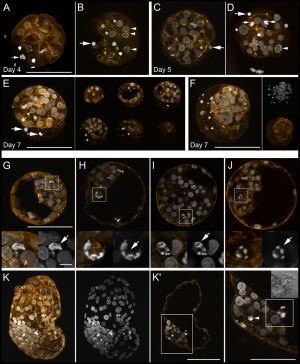
Bovine Morula (day 4)[6]
Bovine Blastocyst (day 7)[6]
Bovine stem cell marker expression[1]
- Links: Image - Morula and Blastocyst | Morula A | Blastocyst F | Blastocyst G | Bovine Development | Morula | Blastocyst
Placenta
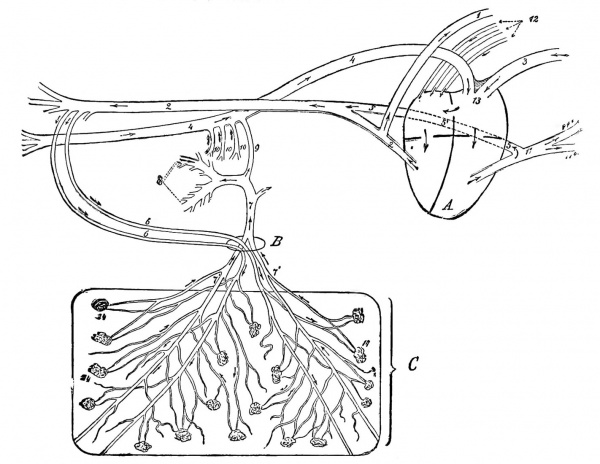
|
Fetal Circulation of a Calf
Placentation is epitheliochorial, where the maternal epithelium of the uterus comes in contact with the chorion, considered as primitive. The arrows indicate the direction in which the blood flows. A, Heart; B, umbilical opening; C, portion of the chorion. 1, Anterior aorta; 2, posterior aorta; 3 anterior vena cava; 4, posterior vena cava; 5, duct of Botalli; part of Botalli's duct posterior to the heart (sketched somewhat too long, but was necessary in order to demonstrate it) ; 6, umbilical arteries; 7, umbilical vein; 7', some of its branches; 8, portal vein; 9, ductus venosus; 10, portal veins: 11, pulmonary artery; 11', some of its branches; 12, pulmonary veins; 13, tuberculum Loweri; 14, chorion papillae. Figure: DeBruin Bovine Obstetrics (1910)
|
Genital Development
Testis
The male bovine (bull) first development of the testis at the genital ridge is triggered by SRY expression following the timeline shown below.[7]
- Day 32 - (CRL 12) Genital ridges first appeared
- Day 37 - (CRL 18) SRY expression begins
- Day 39 - (CRL 20) SRY expression peaks
- Day 42 - (CRL 27) Testis cords distinguishable
- Links: Testis Development
Ovary
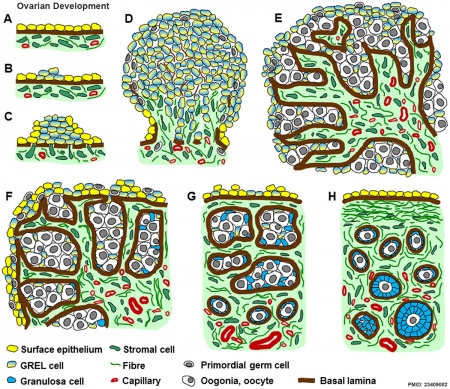
|
Ovarian Development Model[8]
|
References
- ↑ 1.0 1.1 1.2 <pubmed>22479535</pubmed>| PMC3315523 | PLoS One.
- ↑ <pubmed>20103987</pubmed>
- ↑ <pubmed>19064908</pubmed>| PNAS
- ↑ Bruin, M. G. de. Bovine obstetrics (1910) translated by W. E. A. Wyman
- ↑ <pubmed>21401961</pubmed>| Reprod Biol Endocrinol.
- ↑ 6.0 6.1 6.2 <pubmed>21811561</pubmed>| PLoS One.
- ↑ <pubmed>19844082</pubmed>
- ↑ <pubmed>23409002</pubmed>| PLoS One.
Reviews
Articles
Search Pubmed
Search Pubmed: bovine development
External Links
External Links Notice - The dynamic nature of the internet may mean that some of these listed links may no longer function. If the link no longer works search the web with the link text or name. Links to any external commercial sites are provided for information purposes only and should never be considered an endorsement. UNSW Embryology is provided as an educational resource with no clinical information or commercial affiliation.
- Oklahoma State University Learning Reproduction in Farm Animals
| Animal Development: axolotl | bat | cat | chicken | cow | dog | dolphin | echidna | fly | frog | goat | grasshopper | guinea pig | hamster | horse | kangaroo | koala | lizard | medaka | mouse | opossum | pig | platypus | rabbit | rat | salamander | sea squirt | sea urchin | sheep | worm | zebrafish | life cycles | development timetable | development models | K12 |
Glossary Links
- Glossary: A | B | C | D | E | F | G | H | I | J | K | L | M | N | O | P | Q | R | S | T | U | V | W | X | Y | Z | Numbers | Symbols | Term Link
Cite this page: Hill, M.A. (2024, April 18) Embryology Bovine Development. Retrieved from https://embryology.med.unsw.edu.au/embryology/index.php/Bovine_Development
- © Dr Mark Hill 2024, UNSW Embryology ISBN: 978 0 7334 2609 4 - UNSW CRICOS Provider Code No. 00098G
